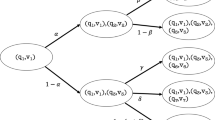Abstract
The problem of a mathematician who walks from her home to her office and changes her mind repeatedly during this walk is discussed. Stochastic generalizations of this problem can be used to model many real-life situations.
Similar content being viewed by others
Suggested Reading
W Feller.An Introduction to Probability Theory aud its Applications. Wiley Eastern. Vol 1. 1968, Vol II. 1970.
Billingsley P.Probability and Measure. Second Edition. John Wiley and Sons. N.Y, 1990.
Zeev Barel. Problem 453.College Mathematics Journal. Vol 22. p 255, 1991.
Krishnapriyan H K.Mathematics Spectrum. Vol 6. p 9, 1995/6.
Ramasamy B and T S K V Iyer.Resonance. Vol 1. No 5. May 1996.
Barnsley M.Fractals Everywhere. Academic Press. 1988.
Author information
Authors and Affiliations
Rights and permissions
About this article
Cite this article
Athreya, K.B. The vacillating mathematician. Reson 2, 16–24 (1997). https://doi.org/10.1007/BF02838776
Issue Date:
DOI: https://doi.org/10.1007/BF02838776




